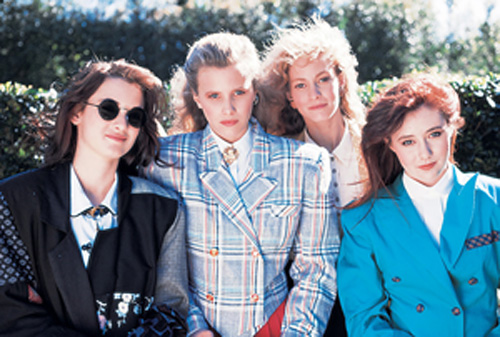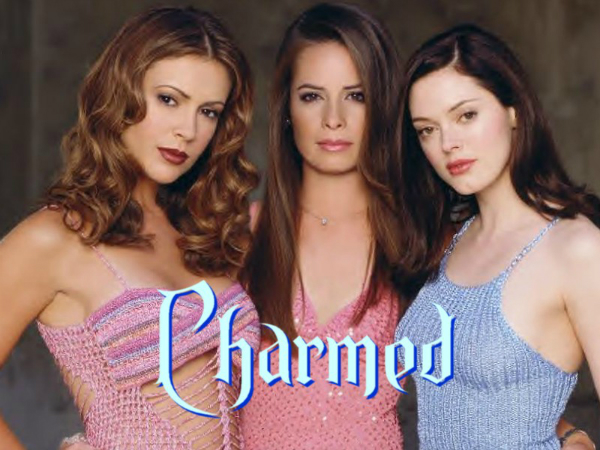This guest post by Alize Emme appears as part of our theme week on Female Friendship.
The 1988 film Heathers, starring Winona Ryder as the hyper-aware, reluctantly popular girl trying to maintain her status with a powerful clique of girls all named Heather, is a cult classic. A snappy dark comedy set in a high school bubble, Heathers touches on difficult subjects including murder and suicide, and nonchalantly addresses major social issues like female friendship and power. The friendships we are introduced to steer every aspect of the story as it progresses and bring us into a world where female characters aren’t just cardboard cutouts but multidimensional, seriously flawed, and sinfully interesting young women.
When we meet Veronica Sawyer (Ryder) she is past the point of enjoying her new popularity and instead is wallowing in painfully self-aware and humorous ramblings in her diary. Her inner monologue serves as an honest look at the cruelty of high school girls, in this case, the clique’s ringleader, Heather Chandler (Kim Walker), with whom she walks a fine frenemy line.
The friendships these characters share are at best a soul-sucking 9-5 job and at worst a dictatorship. For them, being popular is a currency. They use it to inflict pain on unsuspecting peons and to manipulate each other. They are intelligent beyond their years. They relish in the misery of others. They rule the school with an iron fist.
A group of popular mean girls is nothing new, but the one thing Heathers does differently is showcase female power with amazing colors (literally). Specifically, we see female characters displaying traditionally masculine power.
Chandler is a shark. She navigates the power plays of high school like Leonardo DiCaprio’s character in The Wolf of Wall Street (2013) navigates the world of commerce. Perpetually dressed in a crimson shade of red, Chandler makes no apologies for her cutthroat behavior, proudly calling attention to her worshipped status by stating in regard to her peers, “They all want me as a friend or a fuck,” a sentiment relayed by male rap artists J. Cole and Mickey Avalon, and pro wrestler Ric Flair.
The power Chandler displays with Veronica and the other Heathers mirrors that of a macho guy. She tosses around profanity-laced vulgar phrases like an alpha male in a locker room. She’s got the brains and the brawn and the cutthroat mentality of a high-powered man. As other characters rise to power, they adopt the same masculine persona. Women in movies, especially high school movies, are rarely portrayed this way.
After Veronica tosses her cookies at a college party, an embarrassed Chandler vows to make her life hell across their entire Ohio suburb. Fed up with Chandler’s oppressive leadership, Veronica laments to dark and stormy bad-boy new kid Jason “J.D.” Dean (Christian Slater) that she wishes Heather Chandler was dead, rationalizing in a diary entry that it would be a public service to rid the school of such evil.
With slightly less sinister motivation, Veronica and J.D. sneak into the Chandler home and concoct a gag-inducing hangover cure. Veronica balks at J.D.’s suggestion to use liquid drainer but unknowingly serves it to Chandler anyway, killing her instantly. When a stunned Veronica stammers she just murdered her “best friend,” J.D. quips, “and your worst enemy.” Veronica replies, “same difference,” summing up their relationship completely.
Faking Chandler’s suicide comes easy to the morose J.D. and brainy Veronica, who effortlessly forges an eloquent suicide note which skyrockets Chandler’s popularity even higher in death. Veronica’s unsuspecting participation in two additional murders with J.D. drives her to break things off with him and reevaluate her choices.
But it’s the moment Chandler dies that the once-dominating clique experiences a huge power shift. Chandler’s body is in the ground for mere minutes when Heather Duke’s rise to power and eventual takeover of Chandler’s position begins. Duke, played by Shannen Doherty, had been a shy, bookish member of the group, clinging to a copy of Moby Dick in the shadows who in contrast to Chandler’s bright reds, wears green – with envy. She falls to Chandler’s body image pressures and submits herself to be used by Chandler as furniture.
Duke celebrates Chandler’s demise with a huge smile and a bucket of chicken wings, exclaiming, “fuck it,” when Veronica and Heather McNamara (Lisanne Falk) call attention to her sudden hunger. Duke is now hungry for power. When J.D. dangles Chandler’s coveted red scrunchie before her, Duke wastes no time seizing Chandler’s vacated position, promising she can handle the pressure of being a leader.
As Duke’s power grows, pops of red appear in her wardrobe. A red belt here, red shoes there. Until finally, after getting the whole school to sign her prom singer petition, she reclines, covered head to toe in red, with her back arched and feet up, basking in the afternoon sunlight before exclaiming to a perplexed Veronica: “People love me.” Veronica is quick to call Duke out on her sudden transformation and Duke, now embracing her power, demands, “Why are you pulling my dick?” fully adopting that masculine bravado we saw from Chandler. Duke harshly informs Veronica that anyone would want to be popular, no matter the cost.
McNamara, the final Heather, sees her power shift travel in the opposite direction. McNamara’s friendship with Chandler was rooted in control. Chandler’s death relinquishes the hold she had over McNamara but leaves her little ground to stand on. Gone are McNamara’s bright and sunny yellow outfits, replaced with heavy blacks and gray, accessorized only with a single yellow belt or yellow socks. Her turmoil culminates with a failed, but real, suicide attempt. In the film’s rare display of genuine friendship, it is Veronica who saves McNamara from death. It’s a sweet exchange as Veronica offers her shoulder for McNamara to lean on with understanding and solidarity.
The power Chandler and Duke portray is not something to aspire to, Veronica’s inner dialog provides that moral compass, but it is groundbreaking to see female power portrayed in a completely different and masculine light on film.
The girls don’t talk about clothes or boys; McNamara introduces J.D. in a derogatory fashion: “God Veronica, drool much?” making it un-cool that she has a crush. Their resistance to fall to on-screen female friend stereotypes is admirable. At the very least, Heathers succeeds in this area. Whereas other teen high school movies like Clueless (1995) end with finding a boyfriend and the bulk of Mean Girls (2004) conveys one female character taking down another, Heathers ends with Veronica finding and harnessing her power.
Veronica’s transformation springs from her friendship with Chandler. The transition from friend to foe sets off the chain of events for the rest of the film and sparks Veronica’s own journey to owning her power. Veronica is at first reluctantly popular, therefore reluctantly powerful. But her hatred for Chandler leads to her irreversible acts with J.D. and she starts to see herself and her actions with horror.
Veronica continuously returns to the idea that Betty Finn (Renée Esteves) was a true friend who she foolishly ditched for Chandler. But when she invites Betty over to play croquet, a game she played with the Heathers, instead of playing nice, Veronica doesn’t hesitate to be mean for mean’s sake and take the same knockout power shot Chandler did previously. Even Veronica succumbs briefly to power at the cost of her friend. In one of J.D.’s final lines to Veronica he tells her: “You got power, power I didn’t think you had,” a shaky admission to the once reluctant character now able to stand her ground.
Veronica realizes that she can’t allow herself to be used as a pawn in other people’s games, albeit Chandler’s, Duke’s, or J.D.’s. She’s aware that her actions are “teen-angst bullshit.” She takes matters into her own hands and not only does Veronica stop J.D. from blowing up the school, she asserts herself as the “new sheriff in town,” symbolically ripping the red scrunchie from Duke’s head and donning it herself as she struts down the hallway. With her new can’t-mess-with-me power, she vows to do right as the new school leader and offers an olive branch to a previously bullied student, officially clearing the slate for change.
Veronica’s realization that seeking out genuine friendships is more important than popularity is the real takeaway from Heathers. The importance of having female friends that build each other up instead of tear each other down is paramount. We as women should strive to buck the status quo of mainstream movie frienemy friendships and seek out ones that are rooted in respect and support. But as a whole, the message of the film is clear: Don’t be a Heather; find a Betty Finn.
Alize Emme is a writer/director living in Los Angeles. She holds a B.A. in Film & Television from NYU and tweets at @alizeemme.












